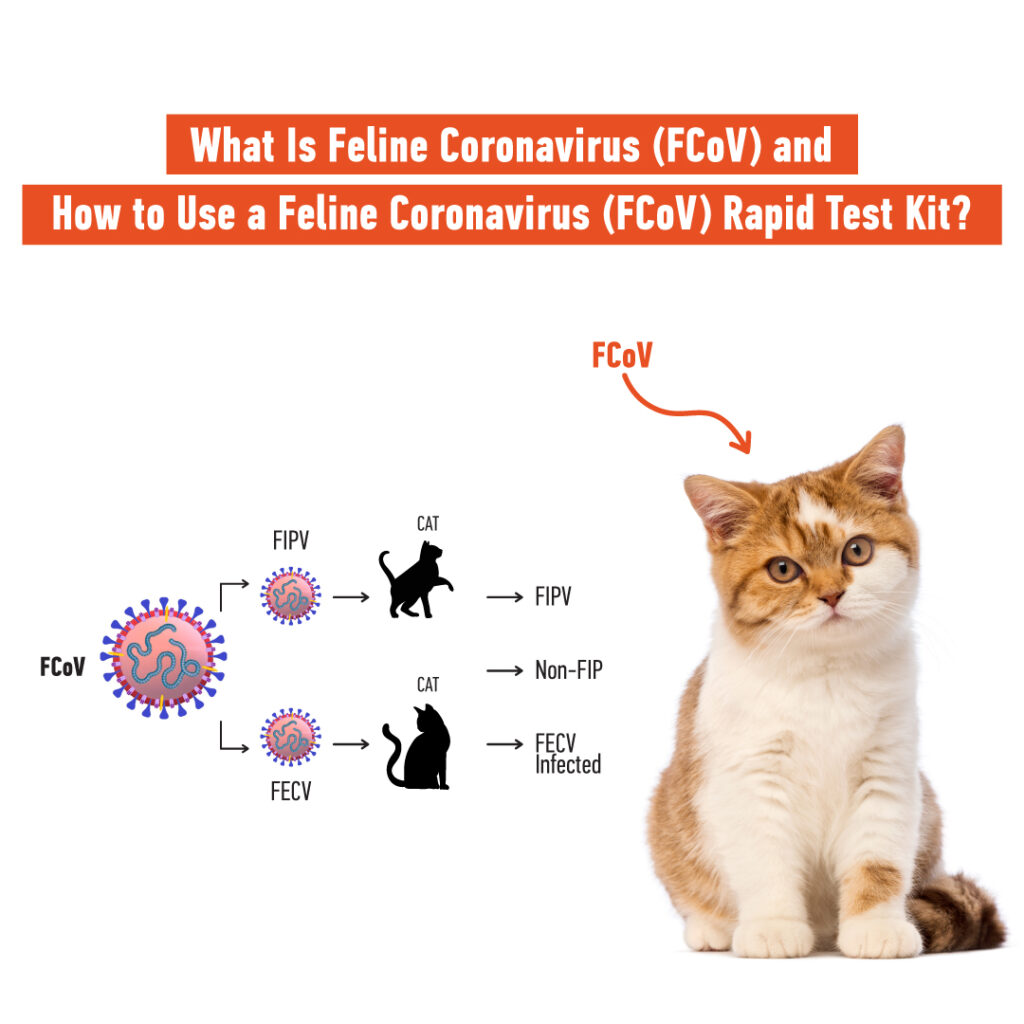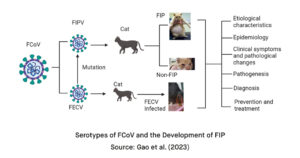
Estimated to affect at least 35 percent of all owned domestic cats, Feline Coronavirus (FCoV) is a highly common and widespread virus. Although it often causes mild and self-limiting gastrointestinal disease, regular screening and early diagnosis of feline coronavirus (FCoV) remain crucial due to its close relation with the occurrence of a fatal systematic infection known as feline infectious peritonitis (FIP). The development of rapid chromatic immunoassays, such as our Feline Coronavirus (FCoV) Rapid Test Kit, offers significant advantages for detecting and differentiating feline coronavirus (FCoV). Read along to learn more about feline coronavirus (FCoV) and feline infectious peritonitis (FIP), along with how the Feline Coronavirus (FCoV) Rapid Test Kit can be used to check for feline coronavirus (FCoV) in clinically suspected cases.
What is Feline Coronavirus (FCoV)?
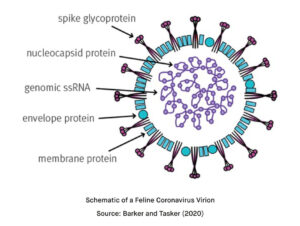
Feline coronavirus (FCoV) is a non-segmented single-stranded RNA virus of the genus Alphacoronavirus 1 in the family Coronaviridae. Feline coronavirus (FCoV) primarily spreads through the fecal-oral route. Infected cats shed large amounts of FCoV virions into the environment through their feces, and healthy cats can contract the infection through direct contact with contaminated environments. Feline coronavirus (FCoV) is classified into two genotypes based on its antigenic properties: FCoV I and FCoV II. Among these, FCoV I is more common and widespread among all natural infections worldwide. Still, FCoV II has attracted significant scholarly attention as its emergence has been linked to a series of recombination events between FCoV I and canine coronavirus (CCoV).
Small intestinal villi enterocytes constitute the main point of host cell entry and replication for both genotypes of feline coronaviruses (FCoV). However, both FCoV I and FCoV 2 can be evaluated under two pathogenically distinct biotypes upon observation: feline enteric coronavirus (FECV) and feline infectious peritonitis virus (FIPV). These biotypes exhibit major differences in terms of their virulence, pathogenicity, and tropism. Among these, feline enteric coronavirus (FECV) presents with mild to moderate gastrointestinal disease that is confined to intestinal mucosal epithelial cells or mesenteric lymph nodes. Feline infectious peritonitis virus (FIPV), on the other hand, is characterized by far more persistent, progressive, severe, and often systemic infection that can affect a wide array of different cells such as monocytes, plasma cells, lymphocytes, or neurocytes.
What is Feline Infectious Peritonitis (FIP)?
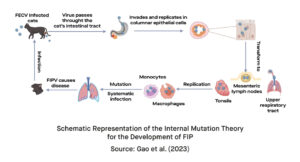
Feline infectious peritonitis (FIP) is a life-threatening systemic infection that develops in around 10% of all cats infected with feline enteric coronavirus (FECV). While feline infectious peritonitis (FIP) is endemic worldwide, the highest incidence of FIP occurs in cats aged three months to 2 years, followed by cats over ten years old. Today, the most widely accepted theory regarding the emergence and pathogenicity of feline infectious peritonitis (FIP) involves a process of internal mutation that is shaped by a combination of viral mutations and inflammatory reactions within the host body. It is currently thought that feline infectious peritonitis (FIP) develops when an infection with feline enteric coronavirus (FECV) extends beyond mature intestinal epithelium and adapts to proliferate in monocytes/macrophages. Through this monocyte/macrophage tropism mechanism, feline enteric coronavirus (FECV) changes in terms of its virulence, switches its biotype and acquires the ability to spread systematically within the host body.
Which Symptoms Should You Watch Out For?
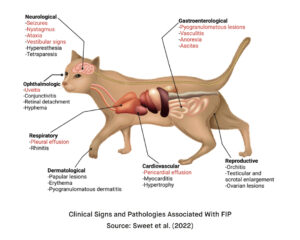
Unlike feline infectious peritonitis (FIP), uncomplicated feline coronavirus (FCoV) cases often solely cause confined and self-limiting disease that is easily treatable upon diagnosis. The majority of cats infected with feline coronavirus (FCoV) present with sub-clinical or mild gastrointestinal symptoms such as diarrhea and vomiting. However, especially in animals with low or compromised immunities, the infection may cause more severe gastrointestinal disease, and dehydration may be a major concern.
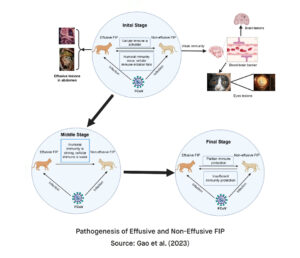
Feline infectious peritonitis (FIP) often presents with symptoms such as lethargy, reduced appetite, undulating fever, dehydration, diarrhea, weight loss, and increased urination. As the infection progresses, feline infectious peritonitis (FIP) cases are classified under two categories depending on disease characteristics. In effusive-type FIP or wet peritonitis, the endothelial damage caused by the inflammatory cytokines released by the virus-laden monocytes as they attach to the walls of small veins leads to the extravasation of proteinaceous fluid into the body cavities. Therefore, the main symptom indicating effusive-type FIP is a painless abdominal swelling that displays a positive fluid wave upon palpation. In non-effusive FIP or dry peritonitis, the extravasated macrophages combine with other inflammatory cells to develop perivascular granulomata. Thus, non-effusive FIP more often presents with mass lesions. Other signs and symptoms of feline infectious peritonitis (FIP) depend on specific organs and systems affected by the granulomatous lesions. As the figure above demonstrates, feline infectious peritonitis (FIP) commonly causes a wide variety of symptoms and complications in the central nervous system (CNS), eyes, liver, kidneys, and across the gastrointestinal tract.
How to Use a Feline Coronavirus (FCoV) Rapid Test Kit?
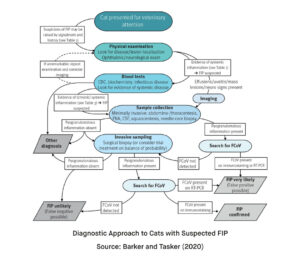
Rapid testing intended to assist the feline coronavirus (FCoV) diagnosis includes both antigen- and antibody-based assays. While rapid antigen tests, such as our VetForTM FCoV Rapid Antigen Test Kit, require the collection of a fecal sample; rapid antibody tests, such as our VetForTM FCoV Rapid Antibody Test Kit, require the collection of a small serum, plasma, or whole blood sample.
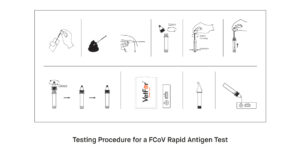
To perform a rapid antigen test for the detection of feline coronavirus (FCoV), a sufficient amount of fecal samples is collected from feline feces or from the rectum by the sterile swab provided within the kit. Once the sample is collected, the swab is inserted into the extraction tube, dipped into the extraction buffer, and rotated a few times along the inner wall of the tube. The textile tip of the swab is squeezed thoroughly along the inner wall of the tube to ensure the transfer of the collected sample into the solution as much as possible. Then, the swab is removed from the tube, and the test cassette is removed from its package. Once the test cassette is placed on a clean and flat surface, a few drops of the processed sample is added to the sample well (S).
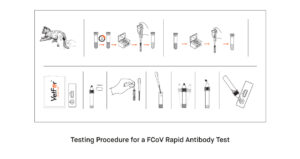
A small volume of whole blood sample is collected with a syringe to perform a rapid antibody test for the detection of feline coronavirus (FCoV). If the test is to be performed on a serum or plasma sample, the collected whole blood sample is centrifuged as instructed in the manual. After the required serum, plasma, or whole blood sample is acquired, a sufficient volume from the collected sample is transferred into the containing the solution and mixed well. Finally, the test cassette is removed from its package to a flat surface, and a few drops of the sample solution are added to the sample well (S).
Both procedures deliver results in typically 10 to 15 minutes. Since it indicates procedural controls and confirms the validity of the results, the control line (C) should always be present at the end of the specified reaction time. If the test line (T) and the control line (C), the sample has tested positive for FCoV antigens or antibodies. If the test line (T) is absent at the end of the specified reaction time, on the other hand, the tested sample is negative for FCoV antigens or antibodies.
REFERENCES
Barker, E. N., & Tasker, S. (2020). Update on feline infectious peritonitis. In Practice, 42(7), 372–383. https://doi.org/10.1136/inp.m3187
Gao, Y., Wang, Q., Liang, X., Zhang, S., Bao, D., Zhao, H., Li, S., Wang, K., Hu, G., & Gao, F. (2023). An updated review of feline coronavirus: mind the two biotypes. Virus Research, 326, 199059. https://doi.org/10.1016/j.virusres.2023.199059
Sweet, A. N., André, N. M., Stout, A. E., Licitra, B. N., & Whittaker, G. R. (2022). Clinical and Molecular Relationships between COVID-19 and Feline Infectious Peritonitis (FIP). Viruses, 14(3), 481. https://doi.org/10.3390/v14030481
